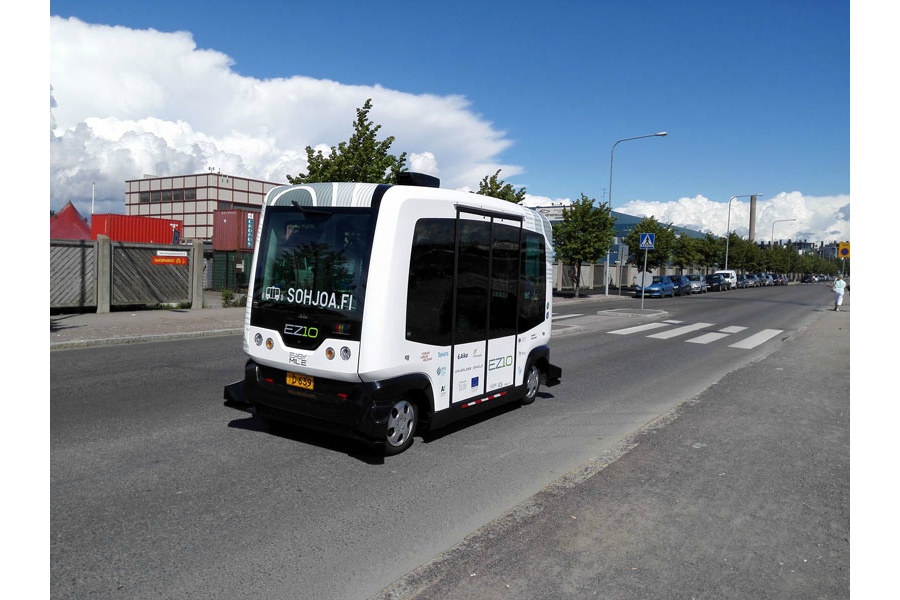Self-driving buses in Helsinki: did Finland just create a new model?
Loading...
Imagine a future where a driverless minibus picks you up at your home and drops you off at a transit hub so you can board a larger bus, subway, or train.
This future is already being tested in Helsinki, Finland. The Scandinavian city is hosting two self-driving minibuses in the first public trials in real traffic. The two EasyMile EZ10 buses will drive up to 12 passengers along a fixed route through most of September, cruising at speeds of up to about 15 mph. The goal, however, is for a fleet to eventually be a “last mile” solution for passengers, Harri Santamala, the road test project lead, and an engineer at Helsinki Metropolia University of Applied Sciences, told Curbed.
“We are not aiming to substitute bigger buses with autonomous buses,” said Mr. Santamala. “We want to bring these somewhere where the conditions don’t permit a normal bus line [because of] a narrow street or it’s not dense enough. We could fill a gap in the mobility chain, make it more efficient and effective.”
EasyMiles's trials come as autonomous buses and other ways to revolutionize public transportation are being tested in select cities and countries across the world. Public transit is where driverless vehicles are likely to be deployed first. Just outside of Washington D.C., Local Motors is a startup company now holding public trials for their driverless Olli minibuses, with the the goal of developing a new way to move urban dwellers around. In the Netherlands, Mercedes Benz is testing semi-autonomous, conventional buses that can navigate roads at up to 43 mph. And Singapore is, perhaps, most aggressively pursuing self-driving car technology to transform its transit system.
At the same time, automakers and technology and ride-hailing companies are also racing to put driverless cars on the road in the next five years. Unlike autonomous buses, private owners and companies would likely own these vehicles.
In order for all these new public and private vehicles to move around in harmony, however, some transport experts say the model EasyMile is testing is key.
“The model of smaller vehicles, whether they’re autonomous or not, connecting to larger public transportation networks is critical for the future of mobility,” says Josh Cohen, director of strategy and partnerships for TransLoc, a transit app that has partnered with Uber to link passengers to public transportation.
In a phone interview with The Christian Science Monitor, Mr. Cohen says cities including Helsinki and London are interested in a future with fewer cars. But, in order for that to happen, conventional and autonomous vehicles, bicycles, and pedestrians must commute in coexistence, he says.
EasyMile in Helsinki has started to explore how this could work out best. From August to mid-September, anyone can be picked up or dropped off along a fixed route through Helsinki’s Hernesaari neighborhood alongside cars and pedestrians. While the minibuses are fully autonomous, they are being monitored remotely, and a supervisor is in each one of them just in case, according to Curbed.
The buses were previously tested on closed roads in the Netherlands and in a Finnish town just north of Helsinki. They are also being tested on private roads in Dubai and Japan, according to EasyMile.
Finland has become a breeding ground for autonomous-vehicle testing, as the country doesn’t require drivers to be behind the wheel on public roads. The Finnish capital of Helsinki is also committed to a future with fewer cars. In 2014, it announced it would make its public transportation so good car ownership would become obsolete, according to The Guardian.
As Uber, Lyft, and other ride-hailing services became more popular across the world, Helsinki planned to turn its public transportation into a point-to-point "mobility on demand." To work towards that goal, the city’s transportation authority launched Kutsuplus, a minibus service (with a driver) that was cheaper than a taxi, but more expensive than bus fare. Passengers were able to schedule their own pick-up and drop-off locations via a smartphone.
But the service went belly up after a year because of costs and low passengers, according to The Guardian. EasyMile could, in theory, pick up where Kutsuplus left off. It would also fall in line with how US transit experts say a future with autonomous cars should look.
"We’re just wringing our hands, and we’re going to object to this, but the transit industry needs to promote shared-use autonomous cars as a replacement for transit on many bus routes and for service to persons with disabilities,” Jerome Lutin, a retired longtime New Jersey Transit planner, told the Transportation Research Board in 2014, as reported by Emily Badger for The Atlantic’s CityLab.
“If autonomous cars can one day better perform some of the functions of transit, shouldn't we let them? Shouldn't we take the opportunity to focus instead on whatever traditional transit does best in an autonomous-car world?” writes Ms. Badger. "The implication in this raises (at least) two more questions: Exactly where (and when) will it make sense for people to use buses or rail instead of autonomous cars? And if autonomous cars come to supplement these services, should transit agencies get into the business of operating them?"
Transit agencies in the US and across the world will continue to wrestle with this question as they and the auto industry explore the future of transportation. For now, though, Helsinkians are becoming more and more comfortable with these two self-driving minibuses.
"Mostly, people have seen the press and aren’t surprised there's a robot bus," said Santamala, the road test project lead and engineer. "But every once in a while we meet local people who haven’t heard about it. They don’t quite believe it. They’re asking, ‘Really? Is it possible that I can get in?’ We’re saying ‘Yes.’"





